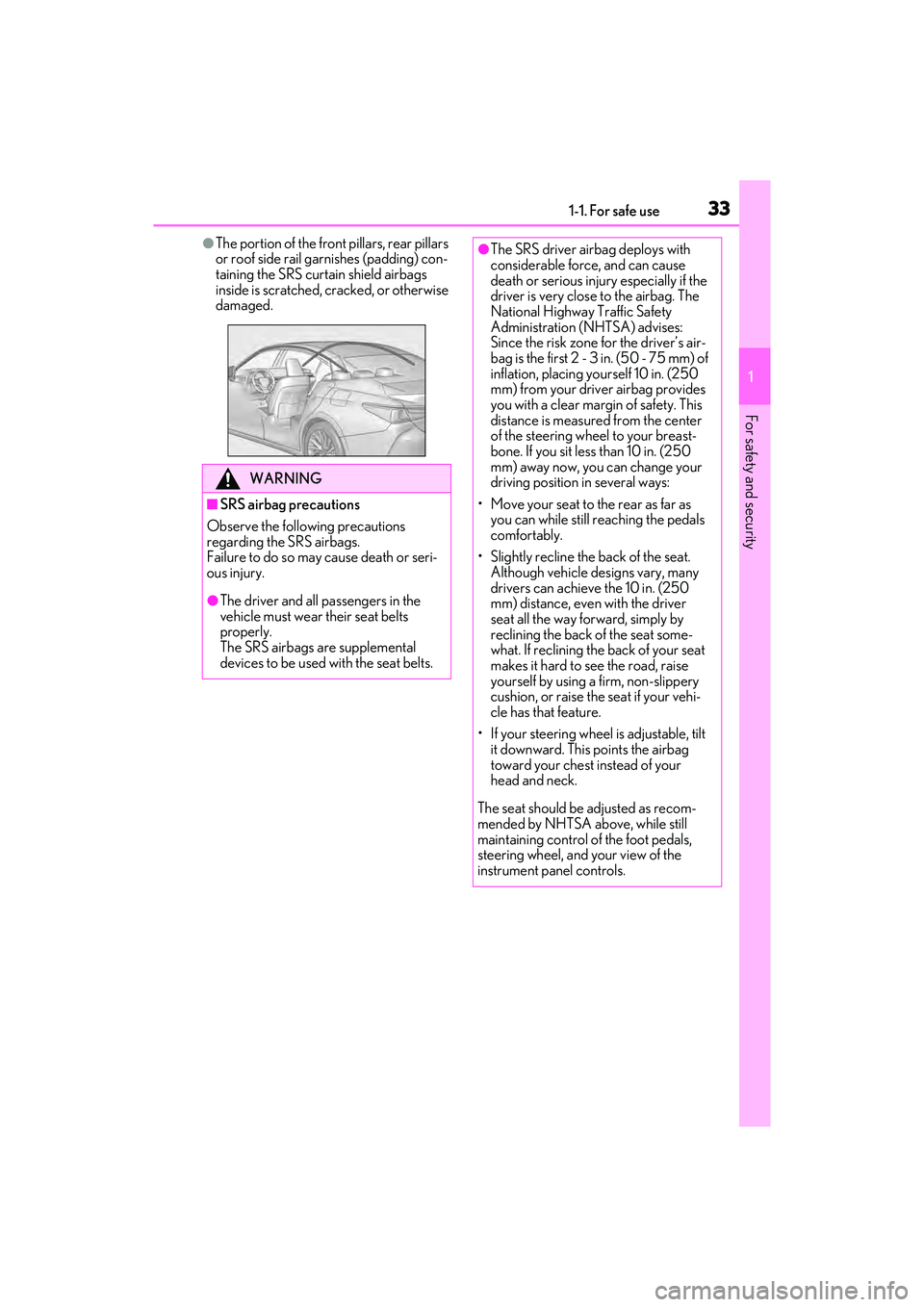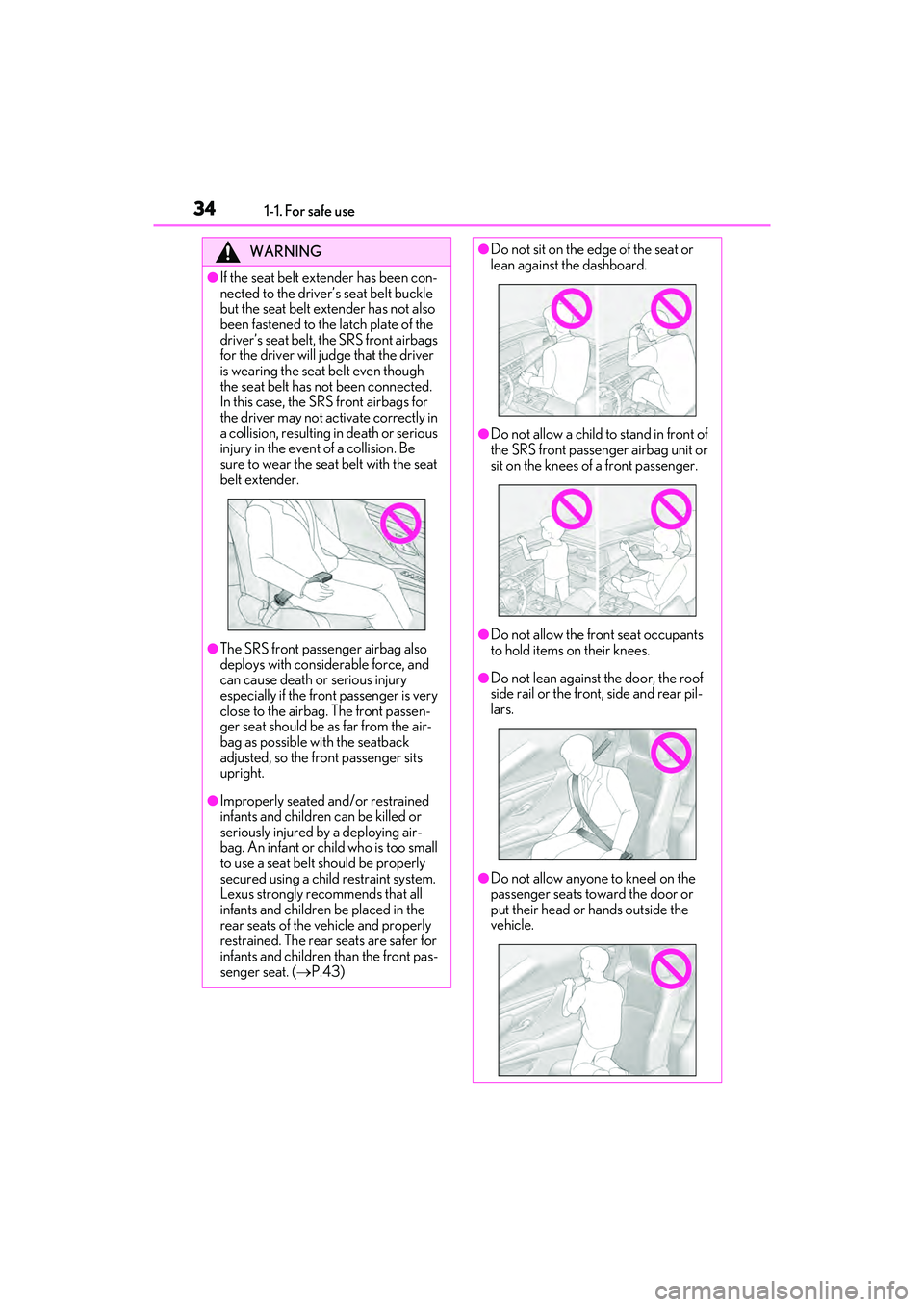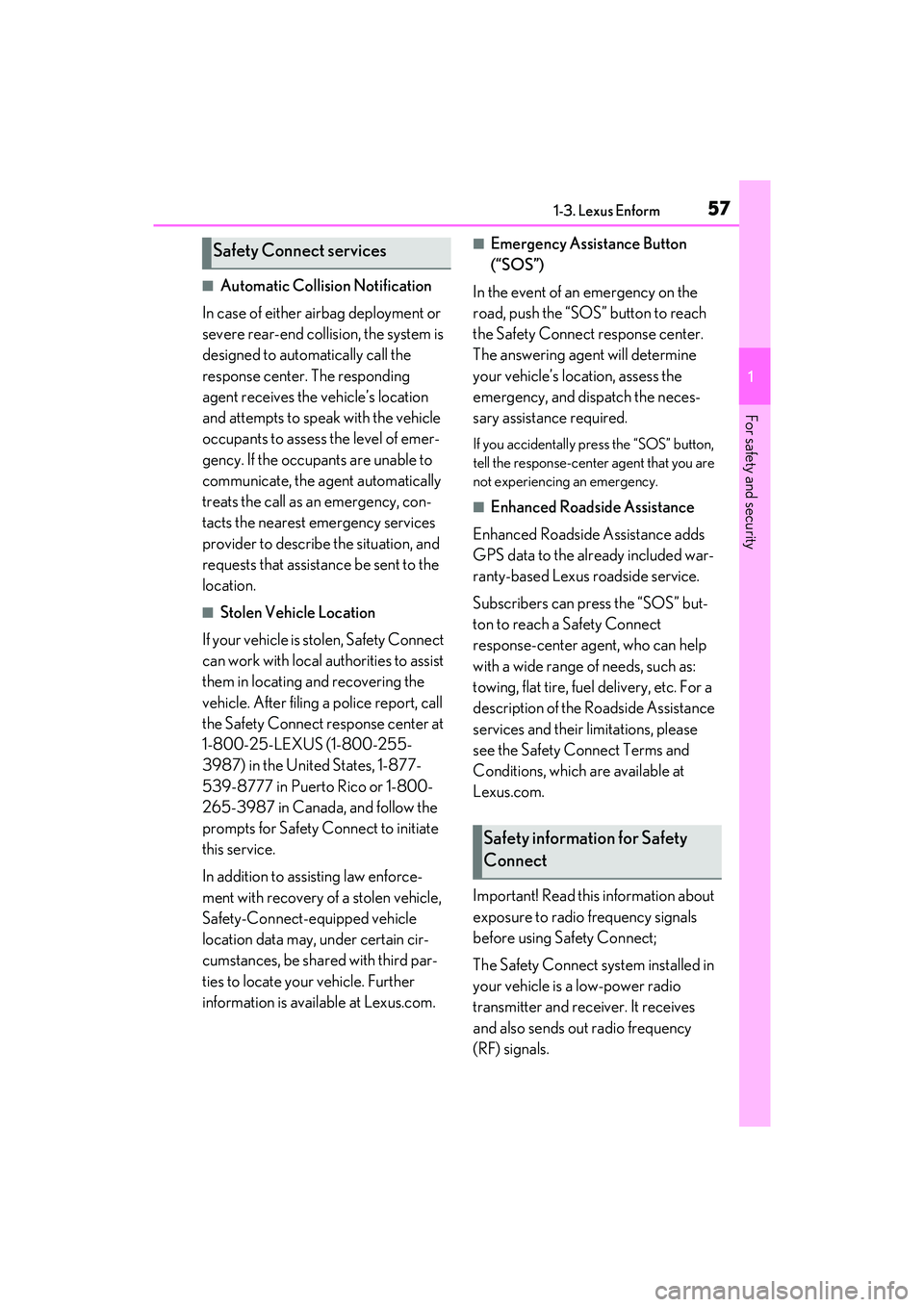2022 LEXUS ES350 tow
[x] Cancel search: towPage 4 of 468

2TABLE OF CONTENTS
For your information ......................................6
Reading this manual .................................... 10
How to search ................................................. 11
Pictorial index ................................................. 12
1-1. For safe use Before driving .................................... 22
For safe driving.................................. 23
Seat belts ............................................. 24
SRS airbags ....................................... 28
Front passenger occupant classifi- cation system ................................. 37
Exhaust gas precautions ............... 42
1-2. Child safety Riding with children........................ 43
Child restraint systems ................. 43
1-3. Lexus Enform Lexus Enform Safety Connect .. 55
1-4. Theft deterrent system Engine immobilizer system ......... 59
Alarm.................................................... 60
2-1. Instrument cluster Warning lights and indicators .... 64
Gauges and meters (except F SPORT models) ........................... 68
Gauges and meters (F SPORT models)............................................... 71
Multi-information display ............. 76
Head-up display .............................. 83
Fuel consumption screen............. 873-1. Key information
Keys ....................................................... 92
3-2. Opening, closing and locking the doors and trunk
Doors .................................................... 96
Trunk .................................................. 100
Smart access system with push- button start.................................... 107
3-3. Adjusting the seats Front seats.......................................... 112
Driving position memory ............. 113
Head restraints ................................ 116
3-4. Adjusting the steering wheel and mirrors
Steering wheel ................................ 118
Inside rear view mirror ................. 119
Outside rear view mirrors......... 120
3-5. Opening and closing the windows and moon roof
Power windows .............................. 123
Moon roof ......................................... 125
Panoramic moon roof ................. 128
4-1. Before driving Driving the vehicle......................... 134
Cargo and luggage...................... 140
Vehicle load limits.......................... 142
Trailer towing................................... 142
Dinghy towing ................................. 143
4-2. Driving procedures Engine (ignition) switch ............... 144
1For safety and security
2Vehicle status information and
indicators
3Before driving
4Driving
Page 6 of 468

4TABLE OF CONTENTS
6-3. Do-it-yourself maintenanceDo-it-yourself service precautions........................................................... 308
Hood................................................... 310
Positioning a floor jack ................ 310
Engine compartment................... 312
Tires ................................................... 320
Tire inflation pressure ................. 328
Wheels.............................................. 330
Air conditioning filter................... 331
Electronic key battery ................ 333
Checking and replacing fuses 335
Headlight aim................................. 337
Light bulbs ....................................... 338
7-1. Essential information Emergency flashers..................... 344
If your vehicle has to be stopped in an emergency ............................. 344
If the vehicle is submerged or water on the road is rising .................. 345
7-2. Steps to take in an emergency If your vehicle needs to be towed........................................................... 347
If you think something is wrong ........................................................... 349
Fuel pump shut off system ........ 350
If a warning light turns on or a warning buzzer sounds ........... 351
If a warning message is displayed ............................................................ 361
If you have a flat tire..................... 365
If the engine will not start .......... 374
If you lose your keys .................... 375If the fuel filler door cannot be
opened .......................................... 376
If the electronic key does not oper- ate properly ................................. 376
If the battery is discharged ....... 379
If your vehicle overheats ........... 382
If the vehicle becomes stuck ... 385
8-1. Specifications Maintenance data (fuel, oil level, etc.) ................................................. 388
Fuel information............................ 397
Tire information ............................ 399
8-2. Customization Customizable features .............. 408
8-3. Items to initialize Items to initialize ............................ 419
9-1. For owners Reporting safety defects for U.S. owners ............................................ 422
Reporting safety defects for Cana- dian owners .................................. 422
Seat belt instructions for Canadian owners (in French) ................... 423
SRS airbag instructions for Cana- dian owners (in French) .......... 424
Headlight aim instructions for Canadian owners (in French)
.......................................................... 430
7When trouble arises
8Vehicle specifications
9For owners
Page 16 of 468

14Pictorial index
■Instrument panel
Engine switch ........................................................................................................... P.144
Starting the engine/changing the mode ......................................................... P.144, 147
Emergency stop of the engine .................................................................................... P.344
When the engine will not start..................................................................................... P.374
Warning messages ................................................................................................. P.145, 361
Shift lever................................................................................................................... P .149
Changing the shift position ............................................................................................ P.150
Precautions against towing........................................................................................... P.347
When the shift lever does not move .......................................................................... P.150
Meters ................................................................................................................... P.68, 71
Reading the meters/adjusting the instru ment panel lights..........P.68, 70, 71, 75
Warning lights/indicator lights ...................................................................................... P.64
When the warning lights come on.............................................................................. P.351
Multi-information display ....................................................................................... P.76
Display ........................................................................................................................ .............. P.76
When the warning messages are displayed........................................................... P.361A
B
C
D
Page 35 of 468

331-1. For safe use
1
For safety and security
●The portion of the front pillars, rear pillars
or roof side rail garnishes (padding) con-
taining the SRS curtain shield airbags
inside is scratched, cracked, or otherwise
damaged.
WARNING
■SRS airbag precautions
Observe the following precautions
regarding the SRS airbags.
Failure to do so may cause death or seri-
ous injury.
●The driver and all passengers in the
vehicle must wear their seat belts
properly.
The SRS airbags are supplemental
devices to be used with the seat belts.
●The SRS driver airbag deploys with
considerable force, and can cause
death or serious injury especially if the
driver is very close to the airbag. The
National Highway Traffic Safety
Administration (NHTSA) advises:
Since the risk zone for the driver’s air-
bag is the first 2 - 3 in. (50 - 75 mm) of
inflation, placing yourself 10 in. (250
mm) from your driver airbag provides
you with a clear margin of safety. This
distance is measured from the center
of the steering wheel to your breast-
bone. If you sit less than 10 in. (250
mm) away now, you can change your
driving position in several ways:
• Move your seat to the rear as far as you can while still reaching the pedals
comfortably.
• Slightly recline the back of the seat.
Although vehicle designs vary, many
drivers can achieve the 10 in. (250
mm) distance, even with the driver
seat all the way forward, simply by
reclining the back of the seat some-
what. If reclining the back of your seat
makes it hard to see the road, raise
yourself by using a firm, non-slippery
cushion, or raise the seat if your vehi-
cle has that feature.
• If your steering wheel is adjustable, tilt it downward. This points the airbag
toward your chest instead of your
head and neck.
The seat should be adjusted as recom-
mended by NHTSA above, while still
maintaining control of the foot pedals,
steering wheel, and your view of the
instrument panel controls.
Page 36 of 468

341-1. For safe use
WARNING
●If the seat belt extender has been con-
nected to the driver’s seat belt buckle
but the seat belt extender has not also
been fastened to the latch plate of the
driver’s seat belt, the SRS front airbags
for the driver will judge that the driver
is wearing the seat belt even though
the seat belt has not been connected.
In this case, the SRS front airbags for
the driver may not activate correctly in
a collision, resulting in death or serious
injury in the event of a collision. Be
sure to wear the seat belt with the seat
belt extender.
●The SRS front passenger airbag also
deploys with considerable force, and
can cause death or serious injury
especially if the front passenger is very
close to the airbag. The front passen-
ger seat should be as far from the air-
bag as possible with the seatback
adjusted, so the front passenger sits
upright.
●Improperly seated and/or restrained
infants and children can be killed or
seriously injured by a deploying air-
bag. An infant or child who is too small
to use a seat belt should be properly
secured using a child restraint system.
Lexus strongly recommends that all
infants and children be placed in the
rear seats of the vehicle and properly
restrained. The rear seats are safer for
infants and children than the front pas-
senger seat. ( P.43)
●Do not sit on the edge of the seat or
lean against the dashboard.
●Do not allow a child to stand in front of
the SRS front passenger airbag unit or
sit on the knees of a front passenger.
●Do not allow the front seat occupants
to hold items on their knees.
●Do not lean against the door, the roof
side rail or the front, side and rear pil-
lars.
●Do not allow anyone to kneel on the
passenger seats toward the door or
put their head or hands outside the
vehicle.
Page 52 of 468

501-2. Child safety
■Removing a child restraint system
installed with a seat belt
Press the buckle release button and
fully retract the seat belt.
When releasing the buckle, the child
restraint system may spring up due to the
rebound of the seat cushion. Release the
buckle while holding down the child
restraint system.
Since the seat belt auto matically reels itself,
slowly return it to the stowing position.
■Child restraint LATCH anchors
LATCH anchors are provided for the
outboard rear seat. (Marks displaying
WARNING
■When installing a child restraint sys-
tem
Observe the following precautions.
Failure to do so may result in death or
serious injury.
●Do not allow children to play with the
seat belt. If the seat belt becomes
twisted around a child’s neck, it may
lead to choking or other serious inju-
ries that could result in death.
If this occurs and the buckle cannot be
unfastened, scissors should be used to
cut the belt.
●Ensure that the belt and plate are
securely locked and the seat belt is not
twisted.
●Shake the child restraint system left
and right, and forward and backward
to ensure that it has been securely
installed.
●After securing a child restraint system,
never adjust the seat.
●When a booster seat is installed,
always ensure that the shoulder belt is
positioned across the center of the
child’s shoulder. The belt should be
kept away from the child’s neck, but
not so that it could fall off the child’s
shoulder.
●Follow all installation instructions pro-
vided by the child restraint system
manufacturer.
●When securing some types of child
restraint systems in rear seats, it may
not be possible to properly use the
seat belts in positions next to the child
restraint without interfering with it or
affecting seat belt effectiveness. Be
sure your seat belt fits snugly across
your shoulder and low on your hips. If it
does not, or if it interferes with the
child restraint, move to a different
position. Failure to do so may result in
death or serious injury.
■When installing a booster seat
To prevent the belt from going into ALR
lock mode, do not fully extend the shoul-
der belt. ALR mode causes the belt to
tighten only. This co uld cause injury or
discomfort to the child. ( P.26)
■Do not use a seat belt extender
If a seat belt extender is used when
installing a child restraint system, the seat
belt will not securely hold the child
restraint system, which could cause
death or serious injury to the child or
other passengers in the event of sudden
braking, sudden swerving or an accident.
Child restraint sy stem fixed with
a child restraint LATCH anchor
Page 59 of 468

571-3. Lexus Enform
1
For safety and security
■Automatic Collision Notification
In case of either airbag deployment or
severe rear-end collision, the system is
designed to automatically call the
response center. The responding
agent receives the vehicle’s location
and attempts to speak with the vehicle
occupants to assess the level of emer-
gency. If the occupants are unable to
communicate, the agent automatically
treats the call as an emergency, con-
tacts the nearest emergency services
provider to describe the situation, and
requests that assistance be sent to the
location.
■Stolen Vehicle Location
If your vehicle is stolen, Safety Connect
can work with local authorities to assist
them in locating and recovering the
vehicle. After filing a police report, call
the Safety Connect response center at
1-800-25-LEXUS (1-800-255-
3987) in the United States, 1-877-
539-8777 in Puerto Rico or 1-800-
265-3987 in Canada, and follow the
prompts for Safety Connect to initiate
this service.
In addition to assisting law enforce-
ment with recovery of a stolen vehicle,
Safety-Connect-equipped vehicle
location data may, under certain cir-
cumstances, be shared with third par-
ties to locate your vehicle. Further
information is available at Lexus.com.
■Emergency Assistance Button
(“SOS”)
In the event of an emergency on the
road, push the “SOS” button to reach
the Safety Connect response center.
The answering agent will determine
your vehicle’s location, assess the
emergency, and dispatch the neces-
sary assistance required.
If you accidentally press the “SOS” button,
tell the response-center agent that you are
not experiencing an emergency.
■Enhanced Roadside Assistance
Enhanced Roadside Assistance adds
GPS data to the already included war-
ranty-based Lexus roadside service.
Subscribers can press the “SOS” but-
ton to reach a Safety Connect
response-center agent, who can help
with a wide range of needs, such as:
towing, flat tire, fuel delivery, etc. For a
description of the Roadside Assistance
services and their limitations, please
see the Safety Connect Terms and
Conditions, which are available at
Lexus.com.
Important! Read this information about
exposure to radio frequency signals
before using Safety Connect;
The Safety Connect system installed in
your vehicle is a low-power radio
transmitter and receiver. It receives
and also sends out radio frequency
(RF) signals.
Safety Connect services
Safety information for Safety
Connect
Page 108 of 468

1063-2. Opening, closing and locking the doors and trunk
between the electronic key and the vehi-
cle (P.109)
●When the vehicle is parked near an elec-
trical noise source or metallic object
which affects the sensitivity of the Hands
Free Power Trunk Lid, such as a pay
parking spot, gas station, electrically
heated road, fluorescent light, or above a
steel plate.
●When the vehicle is near a TV tower,
electric power plant, radio station, large
display, airport or ot her facility that gen-
erates strong radio waves or electrical
noise
●When a large amount of water is applied
to the rear bumper, such as when the
vehicle is being washed or in heavy rain
●When mud, snow, ice, etc. is attached to
the rear bumper
●When the vehicle has been parked for a
while near objects that may move and
contact the rear bumper, such as plants
●When an accessory is installed to the rear
bumper
If an accessory has been installed, turn
the Hands Free Power Trunk Lid (kick
sensor) operation setting off.
■Preventing unintentional operation of
the Hands Free Power Trunk Lid (vehi-
cles with power trunk lid)
When an electronic key is in the operation
range, the Hands Free Power Trunk Lid
may operate unintentionally, so be careful
in the following situations.
●When a large amount of water is applied
to the rear bumper, such as when the
vehicle is being washed or in heavy rain
●When dirt is wiped off the rear bumper
●When a small animal or small object, such
as a ball, moves under the rear bumper
●When an object is moved from under the
rear bumper
●If someone is swinging their legs while sit-
ting on the rear bumper
●If the legs or another part of someone’s
body contacts the rear bumper while
passing by the vehicle
●When the vehicle is parked near an elec- trical noise source which affects the sen-
sitivity of the Hands Free Power Trunk
Lid, such as a pay parking spot, gas sta-
tion, electrically heated road, or fluores-
cent light
●When the vehicle is near a TV tower,
electric power plant, radio station, large
display, airport or other facility that gen-
erates strong radio waves or electrical
noise
●When the vehicle is parked in a place
where objects such as plants are near the
rear bumper
●If luggage, etc. is set near the rear
bumper
●If accessories or a vehicle cover is
installed/removed near the rear bumper
●When the vehicle is being towed
To prevent unintentional operation, turn the
Hands Free Power Trunk Lid (kick sensor)
operation setting off.
■Open door warning buzzer
P.99
■Customization
Some functions can be customized. (Cus-
tomizable features: P.408)
The trunk opener switch can be tem-
porarily disabled to protect luggage
stored in the trunk against theft.
Turn the trunk opener main switch in
the glove box off to disable the trunk
opener.
Protecting luggage against theft